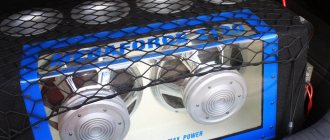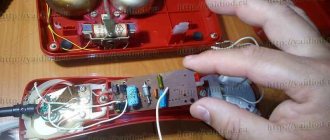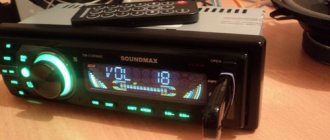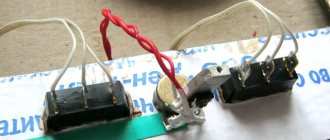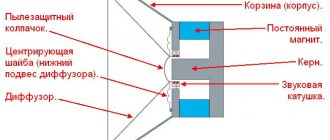A siren is used for sound notification of any process. As a rule, a siren is heard when an alarming event occurs, but radio amateurs use such sounds in various alarm devices. The tone and frequency of such a sound will force attackers to abandon their bad intentions.
By assembling the siren, we have another goal - to improve skills and experience in the development of electronic devices. Since this siren circuit is quite simple and even a novice radio amateur can do it, we will consider in detail the purpose of all elements of the circuit.
Making a siren from a speaker
So, take a long screw with a square nut. You can also use a regular nut. We take the wire, strip it and wrap it in a nut or screw, there is not much difference.
We glue it to the speaker body, to the magnet specifically, along with the wire. Two-component resin or “cold welding” are ideal for this.
Everything is installed in such a way that the bottom of the screw touches one of the flexible wires going to the diffuser.
Solder the second contact to the opposite terminal.
We connect a power source with a voltage of 1.5-9 V. A 3.7 V battery from an old mobile phone will do. Carefully rotate the screw until you hear a persistent siren sound.
The siren is working. If nothing works the first time, change the polarity of the power source.
Related Posts
I took the 3GDSH-1 speakers out of the TVs so that they wouldn’t lie idle and decided to make speakers, but since I have an external amplifier with a subwoofer, that means I’ll be assembling satellites.
Hello everyone, dear radio amateurs and audiophiles! Today I will tell you how to modify the high-frequency speaker 3GD-31 (-1300) also known as 5GDV-1. They were used in such acoustic systems as 10MAS-1 and 1M, 15MAS, 25AS-109…….
Hello dear readers. Yes, it’s been a while since I wrote a blog post, but with all responsibility I want to say that now I will try to keep up and will write reviews and articles…….
Hello dear visitor. I know why you are reading this article. Yes, yes I know. No what are you? I'm not a telepath, I just know why you ended up on this page. Surely......
And again, my friend Vyacheslav (SAXON_1996) wants to share his work on speakers. Word to Vyacheslav I somehow got one 10MAC speaker with a filter and a high-frequency speaker. I haven’t…… for a long time.
How to make a siren with your own hands - instructions
All the necessary details on how to make a siren with your own hands are shown in the photo. Both large and miniature speakers will serve as speakers. To power the siren, a 9-volt Krona battery will do.
Any button (I took it from a laser pointer). Resistors can be of any power. Electrolytic capacitor C1 must be designed for a nominal voltage of 16 V.
Transistors
The location of the contacts of the transistor KT315 and KT814 is shown in the figure. When assembling, it is necessary to correctly connect the contacts (base, collector and emitter) of the transistors, as shown in the diagram and figure.
Otherwise, the transistors may fail. The letter index can be anything.
Assembly
As contacts for the device, I used copper wires with insulation 30-40 cm long. The ends of each wire were stripped and treated with rosin and then with tin. We are slowly assembling according to the diagram, soldering prepared wiring to each part. It is worth noting that you should not overheat the transistors, as this will lead to malfunctions. The electrolytic capacitor must be soldered as shown in the diagram (there will be a + or - sign on its body near the side contact).
The principle of operation of such a siren with your own hands: when you press the button, the sound frequency increases, when you press it, it decreases. The diagram shows that even with the contacts open, the circuit is connected to power (the crown is slowly discharging). This can be corrected by connecting an additional switch.
This is what a homemade siren looks like after everything is soldered correctly. In this case, I connected a miniature speaker (see photo). Such a siren will not be very loud, but absolutely compact. The case for such a device can be used small.
When connecting a speaker of higher power and larger size (see photo), the siren with your own hands will be quite loud. For such a siren it is necessary to find a larger housing.
If you want to use the siren as an alarm or doorbell, instead of the crown it is advisable to connect a power supply with a DC output of 9 to 12 volts.
Good luck with your DIY siren assembly!
See also how to make an electronic flasher with your own hands
Sound alarm device
The sound alarm device (Fig. 5) is made on one K561LE5 microcircuit and two transistors and can be used as a personal security siren, a portable security device of the “traveler’s security device” type, as well as for LED illumination of the keyhole.
This multifunctional device provides: immediate alarm mode; delayed signaling mode; self-shutdown after eliminating the cause of the trigger and automatic entry into the security mode; presence of a warning sound; the ability to use the device as a flashlight (at the same time monitoring the suitability of the batteries).
The sound alarm system, consisting of two generators and an amplifier, is powered by two or three batteries with a total voltage of 3.2...4.5 V. The generated sound signal is two-tone.
Rice. 5. Schematic diagram of the sound alarm device.
The device works as follows. In the off state, the supply voltage from battery GB1 through the chain VD2 and R2 maintains the logical one level at inputs 1 and 8 of the DD1 chip. The current consumed in this case is a few microamps, the battery discharge is practically absent.
When switch SA1 is turned on with a special key (see above), the device is switched to watchdog alarm mode. In this case, it will immediately work when the button (or sensor) SB2 is closed, followed by self-shutdown after a certain time interval (tens of seconds), only if the cause of the sensor operation is eliminated.
The activation of sensor B1 is accompanied by a short warning sound, the duration and volume of which is determined by elements R4 and C1. The siren will turn on if the device is not turned off by the owner within 6... 10 seconds (determined by the R3C3 time constant).
If there are no repeated sensor activations, after a few tens of seconds (60...90 sec, which is determined by the time constant R1C2), the sound signal will turn off and the device will return to the object security mode. The current consumed in this case is a fraction of a milliampere. The maximum current consumed by the device during audible alarm is 200…300 mA.
As sensor B1, a pendulum-spring type contact group is used, consisting of an external metal cup (a cylinder with a diameter of about 10 mm), inside of which a spring twisted from a non-insulated conductor is installed through a dielectric gasket.
The sensor is adjusted in such a way that, in any position of the device, the end of the spring does not close to the external electrode (cylinder), at the same time, even a slight rocking of the device should cause the contact group to close.
An NI LED emitter is used to illuminate, for example, a keyhole, as well as to check the validity of batteries.
How to make a motor siren, manufacturing process:
We cut off the bottom of the pipe plug, and cut out six identical rectangular holes in a piece of pipe:
Powerful motor siren made from a tin can and PVC pipe
Powerful motor siren made from a tin can and PVC pipe
Powerful motor siren made from a tin can and PVC pipe
Using a Dremel, we make 6 petals in a tin can, as can be seen from the photo:
Powerful motor siren made from a tin can and PVC pipe
We bend the petals inside the jar.
Powerful motor siren made from a tin can and PVC pipe
We cut square blanks from the same PVC pipe, you need 12 pieces, glue them together with superglue, 2 pieces each:
Powerful motor siren made from a tin can and PVC pipe
Next we glue these square pieces between the windows inside the 100 mm tube:
Powerful motor siren made from a tin can and PVC pipe
Next we need an electric motor; we put the bottom of a plug for a PVC pipe on its shaft; as you can see, I made the necessary holes in it for mounting to the motor.
Powerful motor siren made from a tin can and PVC pipe
Powerful motor siren made from a tin can and PVC pipe
Powerful motor siren made from a tin can and PVC pipe
We cut out a boss from a piece of wood, drill a hole in the center of it for the motor shaft, it should fit tightly onto it, and 2 blind holes are made at the bottom for screws to attach the boss to a tin can.
Powerful motor siren made from a tin can and PVC pipe
Powerful motor siren made from a tin can and PVC pipe
We screw the wooden boss to the tin can, and then put this structure on the electric motor shaft, and then forcefully insert a piece of tube with rectangular holes into the plug from above.
Powerful motor siren made from a tin can and PVC pipe
Powerful motor siren made from a tin can and PVC pipe
Powerful motor siren made from a tin can and PVC pipe
Powerful motor siren made from a tin can and PVC pipe
Now turning on the motor siren, the electric motor with a tin can quickly spins up, the air flow that is blown out and hitting the walls of the PVC tube creates such a powerful roar, and when using the siren as a security system, it will quickly scare away anyone who entered the room, because it is so loud and the soulful sound of a homemade motor siren will attract the attention of people around you. See our other crafts and DIY projects on our website.
Powerful motor siren made from a tin can and PVC pipe
Powerful motor siren made from a tin can and PVC pipe
See an example of how this motor siren works in the video:
P O P U L A R N O E:
- Sound turn signal
In order not to forget to turn off the turn or handbrake lever, I suggest adding a simple device to your car - a signaling device. The sound alarm is assembled on a common and inexpensive K155LA3 microcircuit. The signaling device is connected to the turn signal or handbrake warning lamp. Read more…
Everything about automatic transmission
Not so long ago, on modern high-class passenger cars, automatic transmission (automatic gearbox) with a torque converter and hydraulic clutches began to be supplemented with two new functions: the Tiptronic function (instant shift function with a light touch of the automatic transmission lever) and the DSP function (adaptive program control function for switching processes). ).
These functions are implemented using electronic automatic control and give the automatic transmission a completely new property - the ability to adapt to driving conditions and the driver’s driving style.
Read more…
Arduino Modules Overview
Arduino Mini, Nano, Uno and Mega.
General information, analysis and programming
Arduino is an interesting electronic construction kit that can be used to create various electronic devices for both beginners and professionals. Modules are very popular due to the convenience of constructing circuits and the simplicity of the programming language. The module is programmed via a regular USB connector, without the use of special programmers. Previously, we looked at several simple Arduino-based circuits.
Read more…
Popularity: 20,818 views.
Security alarm based on motion sensor
The simplest security alarm for a home can be made with your own hands based on a conventional household motion sensor for lighting, which is installed in entrances to save energy. But instead of a lighting lamp, you can install a siren.
What will you need for this?
- Motion sensor - you can buy it at any hardware store, for example OBI or Leroy Merlin. It is necessary to pay attention to the operating voltage of the sensor - we need it to operate from a 220V network; the viewing angle depends on the external design of the sensor (wall-mounted or ceiling-mounted) and the lens used (can be wide 180 degrees or corridor type). Average cost from 400 to 800 rubles;
- Siren operating from a 220V network . For example, PKI-3 “Ivolga-220”, average price 250 rubles. Can be purchased at radio stores;
- A regular switch to turn off the alarm. Any will do, from 100 rubles. and higher.
The connection diagram is shown below:
You need to choose a motion sensor that has at least two types of adjustments - time adjustment (TIME) and sensor sensitivity (SENS). Using the first one, it will be possible to set the activation time of our alarm, i.e. siren sounding time. This value is usually set for five minutes. The second adjustment changes the sensitivity of the sensor, for example, if it does not respond to you or to reduce so-called “false alarms”.
A switch will be needed to turn off the device when you are in its field of view and turn it on when you leave the room. It is advisable to install the switch covertly, so that after activating the security alarm you will not fall within its range of action. In addition to the siren, you can also connect a regular light bulb for double impact on the intruder.
The main disadvantages of this implementation will be that some models of motion sensors, after being turned on, require from 1 to 10 seconds to “stabilize” and switch to standby mode. If you come across such a sensor, you need to add a time relay to the overall circuit, which will keep the siren turned off while it is turned on.
There are also miniature motion sensors on sale that operate on 12V, for example, model DD-03. You can also create a simple alarm on them, but you need to connect it to a 12 volt power source or a battery. Thanks to this, the system will be non-volatile and work even if there are power outages.
Why the bell alarm doesn't work
The howler siren can sometimes fail for some reasons:
- The power was turned off while installing the wired system.
- The entire system was connected incorrectly.
- The batteries in the wireless device are dead.
- The alarm was installed on the street.
- Manufacturing defect.
- The attackers found a way to disable the siren.
- Water, dust, dirt got into the device and shorted the contacts.
When choosing any type of siren-howler alarm, you must carefully read the instructions in order to correctly install and configure the system. Otherwise, your home will not be reliably protected, and unforeseen situations may occur, for example, frequent false alarms. Thanks to the sound warning system, you can be sure that strangers will not enter the territory of your country house or cottage.
A siren is used for sound notification of any process. As a rule, a siren is heard when an alarming event occurs, but radio amateurs use such sounds in various alarm devices. The tone and frequency of such a sound will force attackers to abandon their bad intentions.
By assembling the siren, we have another goal - to improve skills and experience in the development of electronic devices. Since this siren circuit is quite simple and even a novice radio amateur can do it, we will consider in detail the purpose of all elements of the circuit.
